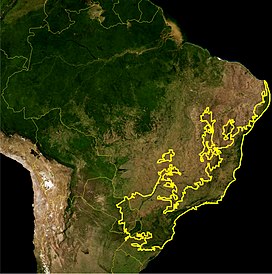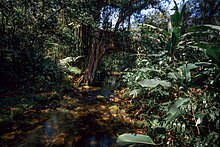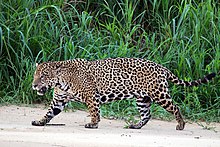Atlantic Forest
| Atlantic Forest Mata Atlântica | |
|---|---|
 Area of the Atlantic Forest in Serra do Mar | |
| Map | |
 Map of the Atlantic Forest ecoregions as delineated by the WWF. The yellow line approximately encloses the forest's distribution. (Satellite image from NASA) | |
| Geography | |
| Location | Argentina, Brazil, Paraguay |
| Area | 1,315,460 km2 (507,900 sq mi) |
| UNESCO World Heritage Site | |
|---|---|
 | |
| Location | Brazil |
| Includes | Una Biological Reserve, PAU Brazil CEPLAC Experimental Station, Veracruz Station, Pau Brasil National Park, Descobrimento National Park, Monte Pascoal National Park, Linhares Forest Reserve and Sooretama Biological Reserve |
| Criteria | Natural: ix, x |
| Reference | 892 |
| Inscription | 1999 (23rd Session) |
| Area | 111,930 ha |
| UNESCO World Heritage Site | |
|---|---|
 View from a trail in the Salto Morato Reserve | |
| Official name | Atlantic Forest South-East Reserves |
| Location | Paraná and São Paulo, Brazil |
| Includes | 25 protected areas |
| Criteria | Natural: (vii)(ix)(x) |
| Reference | 893rev |
| Inscription | 1999 (23rd Session) |
| Area | 468,193 ha (1,807.70 sq mi) |
| Coordinates | 24°10′S 48°0′W / 24.167°S 48.000°W |
The Atlantic Forest (Portuguese: Mata Atlântica) is a South American forest that extends along the Atlantic coast of Brazil from Rio Grande do Norte state in the northeast to Rio Grande do Sul state in the south and inland as far as Paraguay and the Misiones Province of Argentina, where the region is known as Selva Misionera.
The Atlantic Forest has
It was the first environment that the Portuguese colonists encountered over 500 years ago, when it was thought to have had an area of 1,000,000–1,500,000 km2 (390,000–580,000 sq mi), and stretching an unknown distance inland, making it, back then, the second largest rainforest on the planet, only behind the Amazon rainforest.[2] Over 85% of the original area has been deforested, threatening many plant and animal species with extinction.[3][4][5]
Ecology
The Atlantic Forest region includes forests of several variations:
- sedges.[6][page needed]
- Montane Forests.[6]
- Tabuleiro forests are found over very moist clay soils and Tabuleiro Savannas occur over faster-draining sand soils.[6] These are humid areas that rely on water vapor from the ocean.[7]
- Further inland are the Atlantic dry forests, which form a transition between the arid Caatinga to the northeast and the Cerrado savannas to the east. These forests are lower in stature; more open, with high abundance of deciduous trees and lower diversity when compared to tropical moist forests. These forests have between 700–1600 mm of precipitation annually with a distinct dry season. This includes Deciduous and Seasonal semideciduous forest each with their own lowland and montane regions.[6][7]
- Montane forests are higher altitude wet forests across mountains and plateaus of southern Brazil. Also called Araucaria moist forests.
- The Mussununga forests occur in southern Tupi-Guarani meaning soft and wet white sand.[8]
- Shrubby montane Campo rupestre.
The Atlantic Forest is unusual in that it extends as a true
Geography
The Atlantic Forest mainly covers regions of eastern Brazil (92% of the total area), but also reaches eastern Paraguay (6%) and northeastern Argentina (2%).[10]
History
During glacial periods in the Pleistocene, the Atlantic Forest is known to have shrunk to extremely small fragmented refugia in highly sheltered gullies, being separated by areas of dry forest or semi-deserts known as caatingas.[7] Some maps even suggest the forest actually survived in moist pockets well away from the coastline where its endemic rainforest species mixed with much cooler-climate species. Unlike refugia for equatorial rainforests, the refuges for the Atlantic Forest have never been the product of detailed identification.
Biodiversity

Despite having only 28% of native vegetation cover remaining,
The Atlantic Forest is one of the best studied tropical ecosystems. For example, over 3000 tree species, 98 bat species, 94 large or medium-sized mammal species, over 2000 epiphyte species, 26 primate species, 528 amphibian species, 124 small mammal species, and over 800 bird species have been recorded in the Atlantic Forest.[16][17][18][19][20][21][22][23]
New species are continually being found in the Atlantic Forest. In fact, between 1990 and 2006 over a thousand new
Conservation
Human impact

- Agriculture: A major portion of human biofuel crops.[13]
- Pasture: Even more common than using land for agriculture is the slash and burnwhich increases a forest chance of human-induced burning.
- Hunting: Species in a fragmented forest are more susceptible to decline in population size because they are in a confined area that is more accessible to hunters. Larger animals make up the highest percentage of biomass. These animals are also the most rewarding to hunters and are heavily hunted in accessible fragments. This results in a change in species interactions such as seed dispersal and competition for resources.
- Logging: fires. Additionally, logging roads create accessibility for humans; and therefore increases the amount of human land disturbances and decreases the amount of natural forest.[30]
- Fire: Human activity such as logging causes an increase in debris along forest floors that makes the Atlantic Forest more susceptible to fires. This is a forest type that is not accustomed to regular fire activity, so human induced fires dramatically affect the forest understory because plants do not have fire adaptations. In result, the forest becomes even more vulnerable to secondary fires, which are far more destructive and kill many more species including large trees.[30]
Results of human activity
Habitat fragmentation leads to a cascade of alterations of the original forest landscape.[13] For example, the extent of human disturbances, including habitat destruction, in the Atlantic Forest has led to an extinction crisis.[31] The endemic species in this region are especially vulnerable to extinction due to fragmentation because of their small geographic ranges and low occurrence.[32] In a study of the Atlantic Forest fragments, community level biomass was reduced to 60% in plots less than 25 hectares.[33] Key ecological processes such as seed dispersal, gene flow, colonization and other processes are disturbed by fragmentation.[33] With many key vertebrate seed dispersers going extinct, it is predicted that many regional, fruit-bearing tree species in the Atlantic forest will become extinct due to failure of seedling recruitment and recolonisation.[29] With all these species already threatened, it is predicted that with the persistence of current deforestation rates the Atlantic forest will see continued extinction of species.[31]
Conservation by nongovernmental organizations
Due to the Atlantic Forest's vast diversity of endemic plants and animals as well as the fragmentation affecting these species, many groups and organizations are working to restore this unique
Some organizations receive grants from the Critical Ecosystem Partnership Fund if they abide by its rules.[34] These include the Species Protection Program, the Program for Supporting Private Natural Heritage Reserves and the Institutional Strengthening Program.
Another strategy being implemented to maintain biodiversity within the Atlantic Forest is creating
The Pact for Atlantic Forest Restoration has assembled over 100 businesses, nongovernmental and governmental organizations around the goal of having 15 million hectares of the original ecosystem restored by 2050.[38]
The
Ecoregions

- Alto Paraná Atlantic forests
- Araucaria moist forests
- Atlantic Coast restingas
- Bahia coastal forests
- Bahia interior forests
- Caatinga enclaves moist forests
- Pernambuco coastal forests
- Pernambuco interior forests
- Serra do Mar coastal forests
See also
- Atlantic Forest Biosphere Reserve
- Biodiversity hotspot
- Instituto de Tecnologia Intuitiva e Bio-Arquitetura
- List of ecoregions in Brazil
- List of plants of Atlantic Forest vegetation of Brazil
- List of Atlantic Forest conservation units
References
- ^ Dafonseca, G. 1985. The Vanishing Brazilian Atlantic Forest. Biological Conservation 34:17-34.
- ^ Por, Francis Dov. 1992. Sooretama: the Atlantic rain forest of Brazil. The Hague: SPB Academic Pub.
- ^ "The Atlantic Forest". The Nature Conservancy.
- ^ "Atlantic Forests, South America". WWF.
- .
- ^ ISBN 978-0-89327-498-6
- ^ a b c d Galindo Leal, Carlos, and Ibsen de Gusmão Câmara. 2003. The Atlantic Forest of South America: biodiversity status, threats, and outlook. Washington: Island Press.
- ^ Saporetti-Junior et al 2011.
- ISSN 2177-6199.
- ^ Fundación Vida Silvestre Argentina & WWF (2017). State of the Atlantic Forest: Three countries, 148 million people, one of the richest forests on Earth (PDF). Puerto Iguazú, Argentina.: Technical Report. p. 146.
- ISSN 2530-0644.
- PMID 33311511.
- ^ a b c Tabarelli, Marcelo, Antonio Venceslau Aguiar, Milton Cezar Ribeiro, Jean Paul Metzger, and Carlos A. Peres. "Prospects for Biodiversity Conservation in the Atlantic Forest: Lessons from Aging Human-modified Landscapes." Biological Conservation 143.10 (2010): 2328-340.
- ^ de la Sancha, Noé U., Sarah A. Boyle, and Nancy E. McIntyre. "Identifying structural connectivity priorities in eastern Paraguay's fragmented Atlantic Forest." Scientific reports 11, no. 1 (2021): 16129. https://doi.org/10.1038/s41598-021-95516-3
- ^ World Wildlife Fund: Atlantic Forest Archived 2010-04-06 at the Wayback Machine. World Wildlife Fund. 29 November 2011.
- PMID 33311511.
- S2CID 73437737.
- S2CID 182951440.
- S2CID 52979277.
- S2CID 49589547.
- PMID 28500789.
- S2CID 21908829.
- PMID 29266462.
- ^ Reaka-Kudla, Marjorie L, Don E. Wilson, and Edward O. Wilson. Biodiversity II: Understanding and Protecting Our Biological Resources. Washington, D.C: Joseph Henry Press, 1997.
- ^ Pontes, A., A. Malta, and P. Asfora. 2006. A new species of capuchin monkey, genus Cebus erxleben (Cebidae, Primates): found at the very brink of extinction in the Pernambuco Endemism Centre. Zootaxa:1-12.
- ^ Cassano, C., M. Kierulff, and A. Chiarello. 2011. The cacao agroforests of the Brazilian Atlantic forest as habitat for the endangered maned sloth Bradypus torquatus. Mammalian Biology 76:243-250.
- S2CID 90234341.
- S2CID 26608375.
- ^ hdl:10535/3497.
- ^ Laurance, William F., and Diana C. Useche. "Environmental Synergisms and Extinctions of Tropical Species." Conservation Biology 23.6 (2009): 1427-437.
- ^ a b Brooks, Thomas M., Mittermeier, Russell A., Mittermeier, Cristina G., Da Fonseca, Gustavo A. B., Konstant, William R., Flick, Penny, Pilgrim, John, Oldfield, Sara, Magin, Georgina, Hilton-Taylor, Craig. “Habitat Loss and Extinction in the Hotspots of Biodiversity.” Pérdida de Hábitat y Extinciones en Áreas Críticas para la Biodiversidad 16.4 (2002).
- ^ Patterson, B.D. & W. Atmar. "Analyzing species composition in fragments." Bonner Zoologische Monographen 46 (2000): Pp. 9-24.
- ^ a b Pütz, J. Groeneveld, L.F. Alves, J.P. Metzger, A. Huth. "Fragmentation drives tropical forest fragments to early successional states: A modelling study for Brazilian Atlantic forests." Ecological Modelling, 222. 12 (2011), pp. 1986-1997.
- ^ Biodiversity Hotspots- Home. 03 Oct. 2011.
- ^ Iniciativa BNDES Mata Atlântica
- ^ São Paulo Expands Atlantic Forest Protection Coverage. WWF Brasil. 03 Oct. 2011.
- ^ About the Atlantic Forest in Brazil. Nature Conservancy | Protecting Nature, Preserving Life. 03 Oct. 2011.
- ^ Pact for Atlantic Forest Restoration
Bibliography
- Saporetti-Junior, Amilcar Walter; Schaefer, Carlos Ernesto G. Reynaud; de Souza, Agostinho Lopes; Soares, Michellia Pereira; Araújo, Dorothy Sue Dunn; Meira-Neto, João Augusto Alves (21 September 2011). "Influence of Soil Physical Properties on Plants of the Mussununga Ecosystem, Brazil". Folia Geobotanica. 47 (1): 29–39. S2CID 17406247.
External links
- official Atlantic Forest Foundation website — preservation of the Atlantic Forest organization.
- The Nature Conservancy: Atlantic Forest biome — with photos.
- UNESCO World Heritage Site: Discovery Coast Atlantic Forest Reserves
- Mongabay: Mata Atlántica
- ATLANTIC forest boundaries in shapefile


